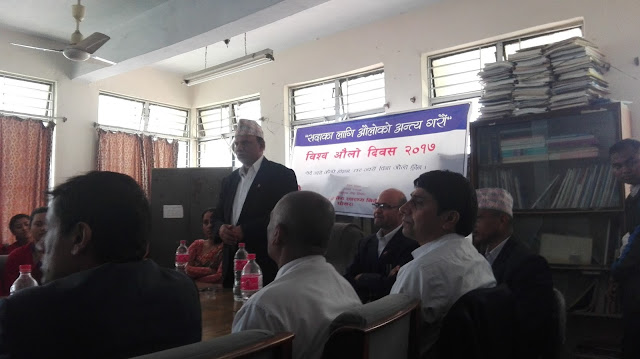April 25
World Malaria Day gives people the chance to promote or learn about the efforts made to prevent and reduce Malaria around the world. It is observed on April 25 each year.
World Malaria Day gives people the chance to promote or learn about the efforts made to prevent and reduce Malaria around the world. It is observed on April 25 each year.
World Malaria Day is an occasion to highlight the need for continued investment and sustained political commitment for malaria prevention and control.
 |
Chief PHA Dinesh Kumar Chapagain, DPHO Kaski |
 |
| RHD, Dr. Taranath Poudel, WRHD |
A push for prevention
This year’s global theme for World Malaria Day is End Malaria for Good. In the lead-up to 25 April, WHO is shining a spotlight on prevention, a critical strategy for reducing the toll of a disease that continues to kill more than 400 000 people annually.
Since 2000, malaria prevention has played an important role in reducing cases and deaths, primarily through the scale up of insecticide-treated nets and indoor spraying with insecticides.
The World Health Organization Regional Office for Africa (WHO/AFRO) announced that Ghana, Kenya, and Malawi will take part in a WHO-coordinated pilot implementation programme that will make the world’s first malaria vaccine available in selected areas, beginning in 2018.
The injectable vaccine, RTS,S, was developed to protect young children from the most deadly form of malaria caused by Plasmodium falciparum. RTS,S will be assessed in the pilot programme as a complementary malaria control tool that could potentially be added to the core package of WHO-recommended measures for malaria prevention. WHO
Key facts
- Malaria is a life-threatening disease caused by parasites that are transmitted to people through the bites of infected female Anopheles mosquitoes.
- In 2015, 91 countries and areas had ongoing malaria transmission.
- Malaria is preventable and curable, and increased efforts are dramatically reducing the malaria burden in many places.
- Between 2010 and 2015, malaria incidence among populations at risk (the rate of new cases) fell by 21% globally. In that same period, malaria mortality rates among populations at risk fell by 29% globally among all age groups, and by 35% among children under 5.
- The WHO African Region carries a disproportionately high share of the global malaria burden. In 2015, the region was home to 90% of malaria cases and 92% of malaria deaths.
NEPAL:
Nepal has surpassed the Millennium Development Goal #6 by reducing malaria morbidity and mortality rates by more than 50% in 2010 as compared to 2000. Therefore, Government of Nepal has set a vision of Malaria free Nepal in 2025. Confirmed cases dropped from 2092 in FY 2069/70 to 1,352 in 2071/72. The proportion of P. falciparum infections has sharply increased and reached 20.26% in reporting year. There is a decreasing trend of confirmed case, case severity with sustaining zero death due to scaling up access to RDT and ACT to public health facilities, high coverage of LLINs in endemic districts and increased socio‐economic status of community people. There is rapid decreasing trend of indigenous PF, whereas slow decreasing trend of indigenous Plasmodium vivax cases indicates that P vivax may remain a challenge for malaria elimination in Nepal. (DoHS, Annual Report 2071/72 (2014/2015)
Read Also:
Disease Control: Malaria (Background, Vision, Mission, Goals, Objectives & Target), Nepal
Read Also:
Disease Control: Malaria (Background, Vision, Mission, Goals, Objectives & Target), Nepal








